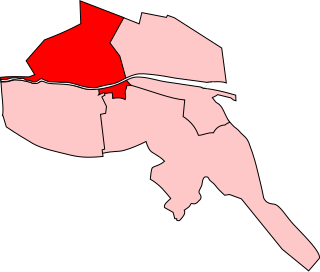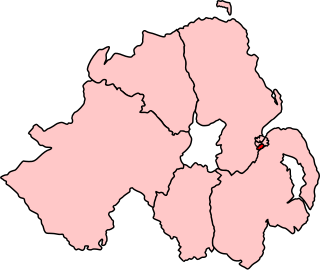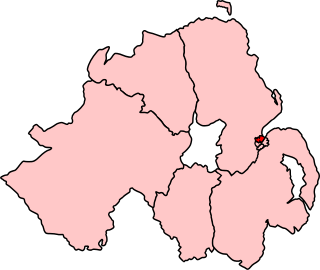Queen's University of Belfast was a university constituency represented in the House of Commons of the United Kingdom Parliament from 1918 until 1950.
West Down was a UK Parliament constituency in Ireland which returned one Member of Parliament from 1885 to 1922, using the first past the post electoral system.
North Fermanagh was a UK Parliament constituency in Ireland which returned one Member of Parliament from 1885 to 1922, using the first past the post electoral system.
South Fermanagh was a UK Parliament constituency in Ireland.
Cromac, a division of Belfast, was a UK parliamentary constituency in Ireland. It returned one Member of Parliament (MP) to the House of Commons of the United Kingdom from 1918 to 1922, using the first past the post electoral system.
Duncairn, a division of Belfast, was a UK parliamentary constituency in Ireland. It returned one Member of Parliament (MP) to the House of Commons of the United Kingdom from 1918 to 1922, using the first past the post electoral system.
Falls, a division of Belfast, was a UK parliamentary constituency in Ireland. It returned one Member of Parliament (MP) to the House of Commons of the United Kingdom from 1918 to 1922, using the first past the post electoral system.
Ormeau, a division of Belfast, was a UK parliamentary constituency in Ireland. It returned one Member of Parliament (MP) to the House of Commons of the United Kingdom from 1918 to 1922, using the first past the post electoral system.
Pottinger, a division of Belfast, was a UK parliamentary constituency in Ireland. It returned one Member of Parliament (MP) to the House of Commons of the United Kingdom from 1918 to 1922, using the first past the post electoral system.
Shankill, a division of Belfast, was a UK parliamentary constituency in Northern Ireland. It returned one Member of Parliament (MP) to the House of Commons of the United Kingdom from 1918 to 1922, using the first past the post electoral system.
Victoria, a division of Belfast, was a UK parliamentary constituency in Ireland. It returned one Member of Parliament (MP) to the House of Commons of the United Kingdom from 1918 to 1922, using the first past the post electoral system.
Woodvale, a division of Belfast, was a UK parliamentary constituency in Ireland. It returned one Member of Parliament (MP) to the House of Commons of the United Kingdom from 1918 to 1922, using the first past the post electoral system.
Mid Down was a UK parliamentary constituency in Ireland. It returned one Member of Parliament (MP) to the British House of Commons from 1918 to 1922, using the first past the post electoral system.

College Green, also called Dublin College Green or College Green Division, Dublin, was a UK parliamentary constituency in Dublin. It returned one Member of Parliament (MP) to the House of Commons of the Parliament of the United Kingdom from 1885 to 1922.
North West Tyrone was a UK parliamentary constituency in Ireland. It returned one Member of Parliament (MP) to the British House of Commons from 1918 to 1922.
The Government of Ireland Act 1920 was an Act passed by the Parliament of the United Kingdom to create two separate parliaments in Ireland: the Parliament of Northern Ireland and the Parliament of Southern Ireland. The Fifth Schedule to this act provided the constituencies for the House of Commons in these two separate parliaments. These same constituencies also replaced those provided in the Redistribution of Seats (Ireland) Act 1918 for representation of Ireland in the House of Commons of the United Kingdom at Westminster. Sinn Féin used these constituencies to elect the Second Dáil (1921–22) and those constituencies in Southern Ireland were used to elect the Third Dáil (1922–23).

Belfast West was a borough constituency of the Parliament of Northern Ireland from 1921 to 1929. It returned four MPs, using proportional representation by means of the single transferable vote.

Belfast South was a borough constituency of the Parliament of Northern Ireland from 1921 to 1929. It returned four MPs, using proportional representation by means of the single transferable vote.

Belfast East was a borough constituency of the Parliament of Northern Ireland from 1921 to 1929. It returned four MPs, using proportional representation by means of the single transferable vote.

Belfast North was a borough constituency of the Parliament of Northern Ireland from 1921 to 1929. It returned four MPs, using proportional representation by means of the single transferable vote.




